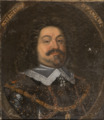Breitenfeld (1642) order of battle facts for kids
The Second Battle of Breitenfeld was a very important battle during the Thirty Years' War. It took place in 1642 near Breitenfeld, Germany. This battle was fought between the Swedish Army and the combined forces of the Holy Roman Empire and Saxon troops. It was one of the last big battles of the war, with more than 20,000 soldiers on each side. It was also rare because both armies decided to attack each other!
Contents
What Led to the Battle?
The Swedish Army had been trying to capture the Saxon fortress of Leipzig. But when the Imperial and Saxon armies came closer, the Swedes stopped their attack on Leipzig. They moved their troops to find a better place to fight. The Imperial commanders thought the Swedes were running away in a messy retreat.
Archduke Leopold Wilhelm of Austria and Ottavio Piccolomini were the main commanders for the Imperial and Saxon forces. Piccolomini thought it was a bad idea to attack the Swedes in an open field, especially since the armies were almost the same size. But the Archduke and his war council disagreed. They ordered an attack. The Swedes were ready and waiting in battle formation at Breitenfeld. This was the same place where the famous Swedish king, Gustavus Adolphus, won a big victory in 1631.
How the Battle Unfolded
Both armies lined up in a similar way. They had two groups of cavalry (soldiers on horseback) on the sides. Their infantry (soldiers on foot) were in the middle. The infantry was split into two parts because some woods cut through the Imperial lines.
Early in the battle, some Imperial and Saxon regiments on the left side quickly broke and ran away. This gave the Swedes a big advantage on that part of the battlefield. On the other side, the Imperial right wing was doing well against the Swedish left.
But then, the Swedish commander, Lennart Torstensson, made a smart move. He sent many of his victorious troops from his right wing. They went around the woods and behind the Imperial center. From there, they attacked the Imperial right wing from behind! This surprise attack pushed the Imperial forces back.
Most of the Imperial army was forced to retreat. Only a few brave regiments, like the Leibregiments and those led by Alt- and Neu-Piccolomini, Mislik, Borneval, and Luttke, held their ground long enough. They covered the retreat of their comrades. However, the Imperial left group was completely surrounded by the Swedes and had to surrender.
Key Commanders
Imperial-Saxon Army Leaders
The main leaders for the Imperial-Saxon army were Archduke Leopold Wilhelm of Austria and Field-Marshal Ottavio Piccolomini.
- Ottavio Piccolomini: He was an experienced commander. He advised against attacking the Swedes in the open field, but his advice was not followed.
- Archduke Leopold Wilhelm of Austria: He was the overall commander and made the final decision to attack.
Swedish Army Leaders
The Swedish Army was led by Field Marshal Lennart Torstensson.
- Lennart Torstensson: He was a brilliant Swedish commander. His clever move of sending troops around the woods helped win the battle.
- Arvid Wittenberg: A major general who commanded the Swedish right wing.
- Torsten Stålhandske: Another major general who helped lead the Swedish right wing.
- Johan Lilliehöök: He was in charge of the Swedish center.
- Carl Gustaf Wrangel: A major general in the Swedish center.
- Hans Christoff von Königsmarck: A major general who commanded part of the Swedish left wing.
Images for kids






